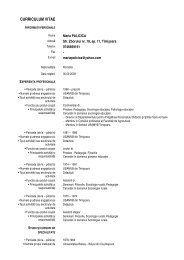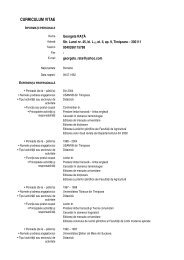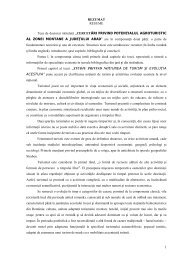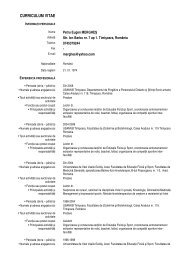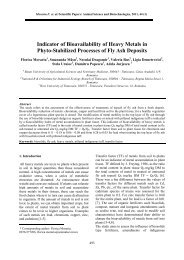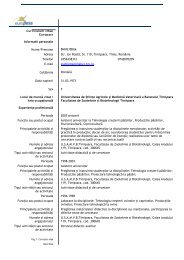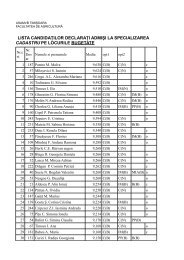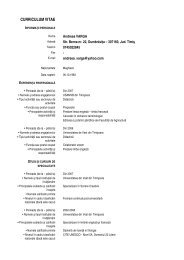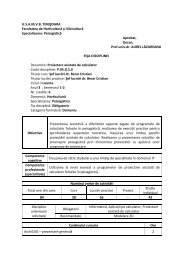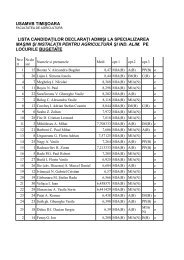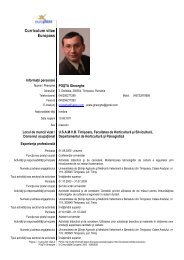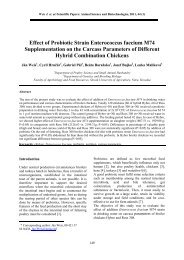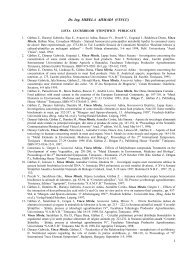Heavy Metals Acting as Endocrine Disrupters
Heavy Metals Acting as Endocrine Disrupters
Heavy Metals Acting as Endocrine Disrupters
Create successful ePaper yourself
Turn your PDF publications into a flip-book with our unique Google optimized e-Paper software.
Georgescu B. et. al./Scientific Papers: Animal Science and Biotechnologies, 2011, 44 (2)is <strong>as</strong>sociated with incre<strong>as</strong>ed dise<strong>as</strong>e risksincluding bladder, lung, skin and other cancers.Moreover, pilot data suggest diabetogenic,neurological and reproductive effects, likewise.Incre<strong>as</strong>ed health risks may occur at levels <strong>as</strong> low<strong>as</strong> 10-50 ppb, while biological effects have beenobserved in experimental animal and cell culturesystems at much lower levels.Arsen is the first metal to be linked with endocrinedisruption through binding to the glucocorticoidreceptor and interfering with glucocorticoidhormones activity in several biological processes.In fact, instead of activating the glucocorticoidreceptor, <strong>as</strong> for example organochlorine pesticidesdo after binding to the estrogen receptor, As ratherinhibits glucocorticoid receptor-mediated geneactivation. In a similar manner, this metalinterferes with the estrogen receptor. Experimentshave shown that As markedly suppressed estrogenreceptor-dependent gene transcription of the 17ßestradiol-induciblevitellogenin gene in chickenembryo liver [2]. In cell cultures, non-cytotoxicconcentrations of As of 2-225 ppb significantlyinhibited estradiol receptor-regulated effects inhuman bre<strong>as</strong>t cancer MCF-7 cells [2].3. Cadmium (Cd)The main sources of contamination with Cd arerepresented by industrial aerosols, water w<strong>as</strong>tesfrom extraction mines, phosphate-b<strong>as</strong>ed fertilizers,Cd-containing pesticides etc. It h<strong>as</strong> beendocumented that in the industrial area, Cdconcentration in the air peaks to 0.03 mg Cd/ m 3 .Fodder plants are the main constituents throughwhich Cd enters the food chain. It w<strong>as</strong> shown thatCd levels in fodder may attain on average 0.6ppm. Moreover, through the process ofbioaccumulation, it reaches even higher concentrationsin animal products and subproducts.Interestingly, the accumulation process is agedependent,due to the long half-time of the metals,with up to 20 years needed for Cd to becompletely metabolized in human. Significantlyhigher Cd concentrations were demonstrated inmales compared to females, in various tissues andorgans such <strong>as</strong> liver, kidney, muscle, blood, hairand wool. A particular high affinity is describedfor the kidney cortex and the testes. Milk levels ofCd are about 2-10 mcg/l, however, they incre<strong>as</strong>eabout tenfold in c<strong>as</strong>es of abnormal exposure. Themetal is excreted in feces and urine but also milkand bile. The free fraction is rapidly metabolized,where<strong>as</strong> the protein-bound fraction accumulatesfor years <strong>as</strong> a metaloprotein (metallothionein).Metallothioneins are cysteine-rich, low-molecularweight proteins, that have the capacity to bindvarious heavy metals (selenium, zinc, copper,cadmium, mercury, arsen, nickel, silver) throughthe thiol group of their cysteine residue. However,it appears that the formation of metallothioneinsh<strong>as</strong> no impact on heavy metals toxicity.International guidelines restrict Cd concentrationto 1 mg/l water. By Romanian guidelines, theselevels are 0,01 ppm for milk, salted fish and oils;0.05 ppm for cheese, meat and meat products;0.03 ppm for vegetables. Despite its presence invery low concentrations in water, Cd mayaccumulate in the phytoplancton and enter theaquatic trophic chain, thus bioaccumulating inmolluscs, crustaceans and fish.Several data indicate that even low-level exposureto Cd interferes with the activity of steroidhormones in both male and female reproductiveorgans. Cd disrupts steroidogenesis by interferingwith the biosynthesis of androgens, estrogens andprogesterone in vivo and in vitro experiments,thus, leading to disturbed sex differentiation andaltered gametogenesis. On the other hand, it maybind both the estrogen and androgen receptor. Inutero animal exposure to Cd induces histologicalchanges in the bre<strong>as</strong>t linked with bre<strong>as</strong>t cancer [3,4]. Recently, a Lithuanian study brought evidenceof significantly higher Cd levels in bre<strong>as</strong>t tissueand biological media from women with bre<strong>as</strong>tcancer compared to controls, thus, suggesting thatexposure to Cd could be interpreted <strong>as</strong> a potentialrisk factor for bre<strong>as</strong>t cancer [5].4. Mercury (Hg)Organic mercury fungicides are widely used inagriculture. In addition, mercury is used <strong>as</strong> acatalyser in industrial processes. In the form ofaerosols it is largely spread in the environment.Mercury polluted water forms sediments furthermetabolized by microorganisms into methylmercury,which is a stable but highly neurotoxicand teratogenic compound. Some organic mercuryderivates accumulate in plants by absorption fromsoil and water through the plants roots. Forexample, use of organic mercury fungicides inagriculture resulted in contamination of potatoestubercles reaching a concentration of 0.03-0.2ppm mercury. A direct correlation w<strong>as</strong> foundbetween the Hg content in fodder and the90



